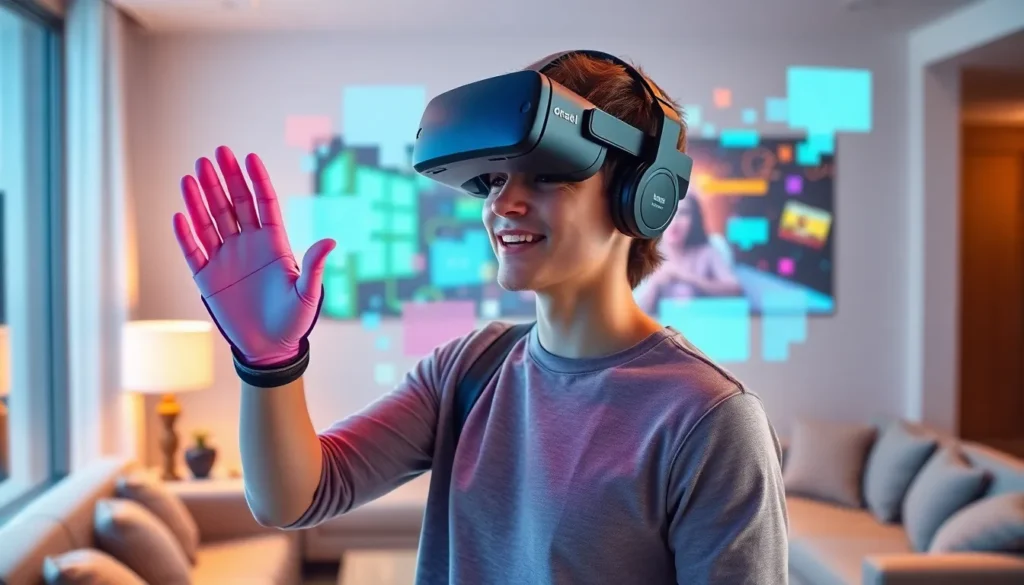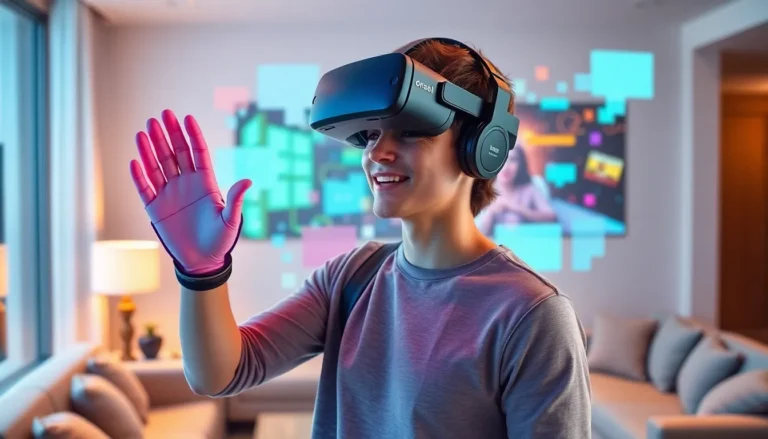Table of Contents
ToggleIn a world where attention spans are shorter than a cat video, brands are scrambling for innovative ways to stand out. Enter virtual reality technology—a game changer that’s not just for gamers anymore. Imagine a brand experience so immersive it makes you feel like you’re not just watching an ad but living it. That’s the magic of VR.
As companies dive into this digital playground, they’re discovering that VR isn’t just a flashy gimmick; it’s a powerful tool for storytelling and engagement. With the ability to transport consumers into entirely new worlds, brands can create memorable experiences that stick. So, if you think branding is all about logos and taglines, think again. VR is here to turn that notion on its head and make your brand unforgettable—one virtual experience at a time.
The Evolution of Branding Through VR Technology
Virtual reality technology has transformed branding in significant ways. Companies now create immersive experiences that engage consumers on a deeper level. With VR, brands can craft storytelling that transports audiences into captivating environments. This technology allows for a memorable interaction that traditional media can’t replicate.
Marketers increasingly utilize VR to build emotional connections with consumers. For example, a travel agency might use VR to simulate a beach destination, allowing potential clients to explore their next vacation from home. Such experiences influence purchasing decisions, driving more sales.
Brands also leverage VR for product demonstrations. Consumers can engage with products virtually, enhancing understanding and reducing uncertainties. Interactive environments enable users to see features in real-time, making the buying process smoother.
Furthermore, data shows that VR experiences lead to higher brand recall. Studies indicate that brands using VR can boost brand recognition by up to 70%. Engaging customers with immersive content fosters loyalty and creates lasting impressions.
Innovative companies experiment with VR events. These events allow global audiences to participate in product launches or brand experiences without geographical limitations. Enhanced accessibility increases brand awareness and forges community connections.
As the technology continues to evolve, brands invest more in VR strategies. The integration of augmented reality (AR) and VR provides even richer experiences. These advancements ensure that branding through VR will remain a significant trend in marketing, creating impactful consumer interactions.
Benefits of VR Technology in Branding
VR technology offers several advantages for branding, particularly through enhanced customer engagement and immersive experiences. Brands increasingly use VR to create lasting impressions on consumers.
Enhanced Customer Engagement
Engaging customers becomes effortless with VR technology. Consumers can interact with products in a virtual space, which fosters a sense of connection. Statistics reveal that brands utilizing VR enjoy a significant increase in customer interaction, leading to an estimated 70% boost in brand recall. Users recall experiences better when actively participating. This interactivity not only attracts attention but also encourages consumers to share experiences on social media platforms. The potential for virality enhances brand visibility further, expanding reach across diverse demographics.
Immersive Brand Experiences
Immersion in virtual environments transforms the way consumers perceive brands. By simulating real-world scenarios, VR allows customers to experience products or services distinctly. For instance, a travel agency can create a virtual tour of a destination, influencing decisions more effectively than traditional advertising. Consumers feel an emotional connection when immersed in these virtual narratives. This connection enhances customer loyalty, as participants are likely to remember the experience and associate positive feelings with the brand. In turn, brands can cultivate stronger relationships with their audience through these memorable moments.
Case Studies of Successful Branding Through VR Technology
Leading brands demonstrate innovative uses of VR to enhance their marketing strategies. IKEA employs VR to allow customers to explore virtual showrooms, creating an immersive shopping experience. Anheuser-Busch uses VR to showcase its breweries, enabling consumers to journey through the beer-making process. Mercedes-Benz engages potential buyers through VR test drives, providing a realistic feel for their vehicles. These brands illustrate how VR technology effectively captivates audiences and promotes their offerings.
Impact on consumer perception markedly improves with VR experiences. Research indicates that engagement levels increase, resulting in elevated brand recall rates, sometimes up to 70%. Consumers often feel a stronger emotional connection when interacting with brands in virtual environments. This connection amplifies brand loyalty and influences purchasing decisions. Companies recognizing the significance of these immersive experiences can craft marketing strategies that resonate deeply with their target audiences.
Future Trends in Branding Through VR Technology
Emerging technology trends shape how brands leverage virtual reality for engaging consumers. Continuous advancements promise to redefine consumer experiences and brand interactions.
Innovations on the Horizon
Brands are set to integrate artificial intelligence with VR, creating personalized experiences for users. 360-degree video content stands to become more prevalent, allowing brands to present immersive narratives. Enhanced sensory feedback through haptic technology offers deeper connections as consumers interact with virtual products. Multi-user environments could enable collaborative experiences, fostering community engagement. Research indicates that such innovations can increase consumer retention significantly. Notably, brands adopting these advanced methods are likely to benefit from elevated storytelling and emotional engagement.
Potential Challenges and Solutions
Adoption challenges persist as brands explore VR technology. High costs may deter smaller companies from entering the market. Additionally, technical complexity can lead to implementation hurdles. Brands must invest strategically in training and deployment to mitigate this risk. Concerns about consumer privacy can arise during immersive experiences. Addressing these issues through transparent data practices encourages trust. Collaborating with experienced tech partners also eases the transition, enabling brands to realize the full potential of VR without overwhelming obstacles.
Embracing VR technology is reshaping branding strategies and creating opportunities for deeper consumer engagement. As brands explore immersive experiences they’re not just capturing attention but also fostering emotional connections that drive loyalty. The potential for VR to transform how consumers interact with products and services is immense.
With advancements in technology on the horizon brands that invest in VR will likely stay ahead of the curve. The combination of VR with other innovations like AI and haptic feedback will further enhance brand experiences. By navigating the challenges associated with VR adoption companies can unlock new pathways to connect with their audiences in meaningful ways.







